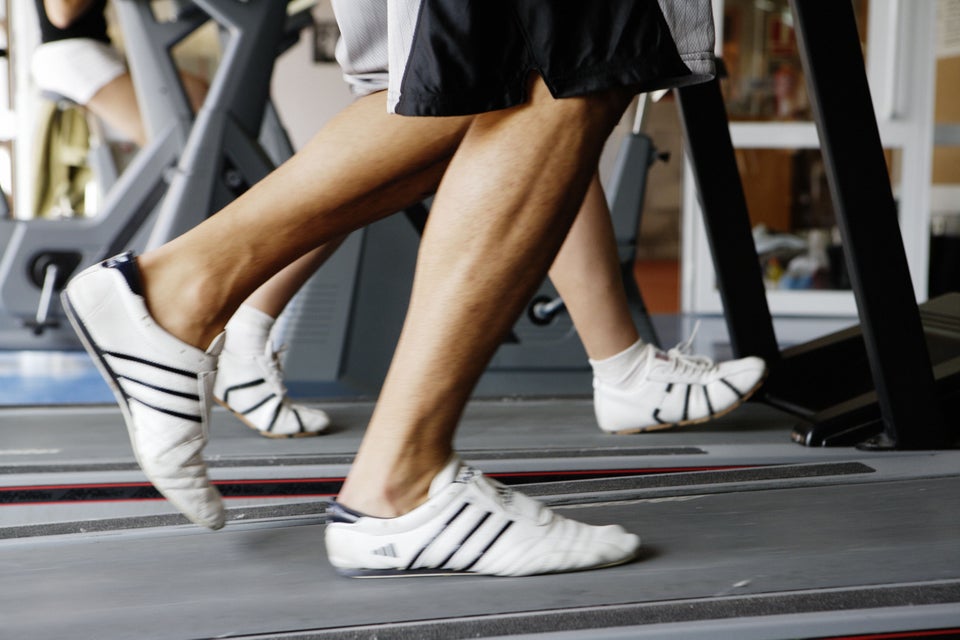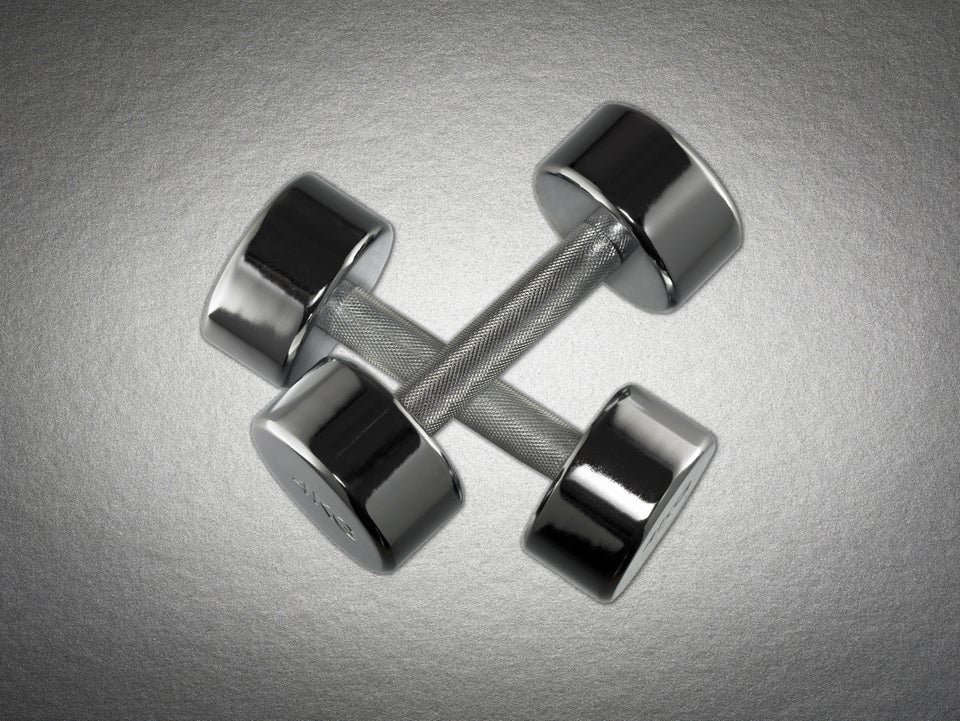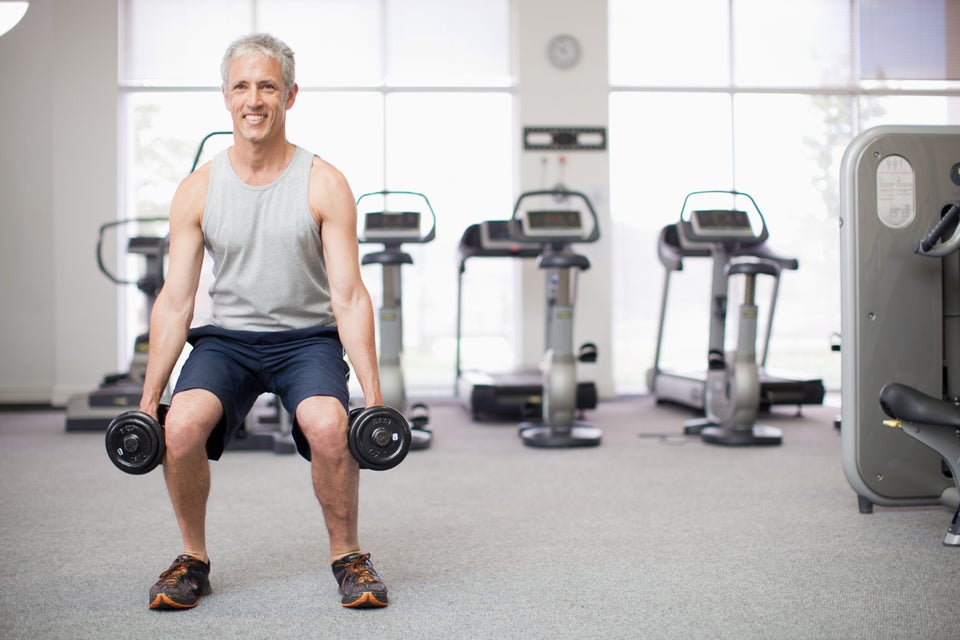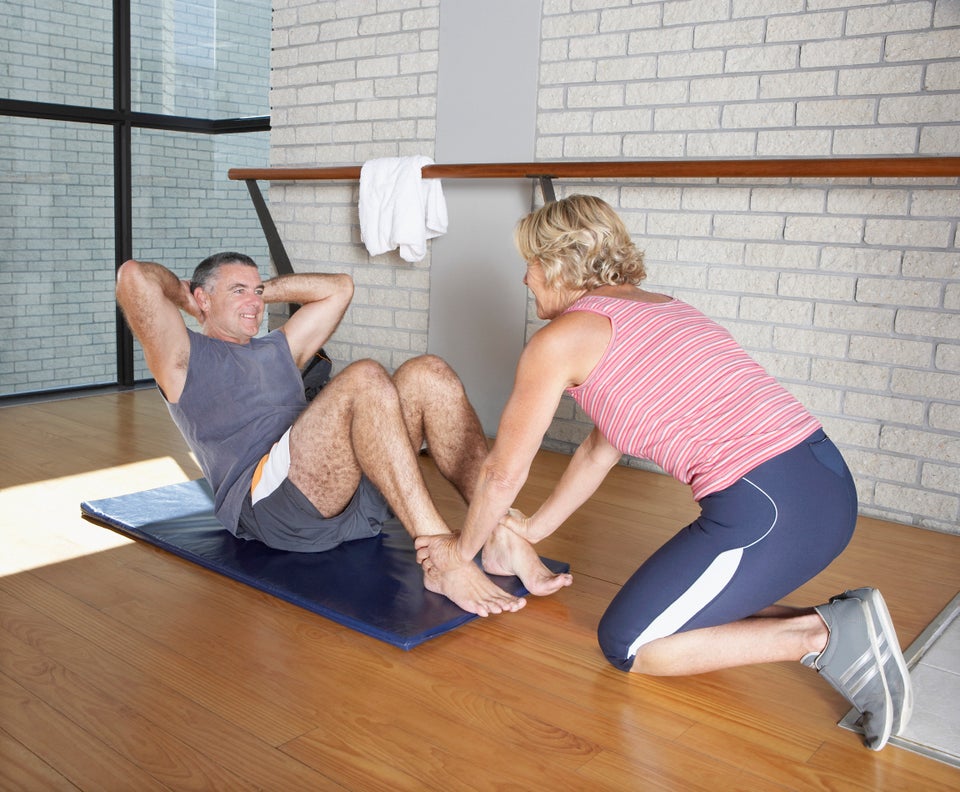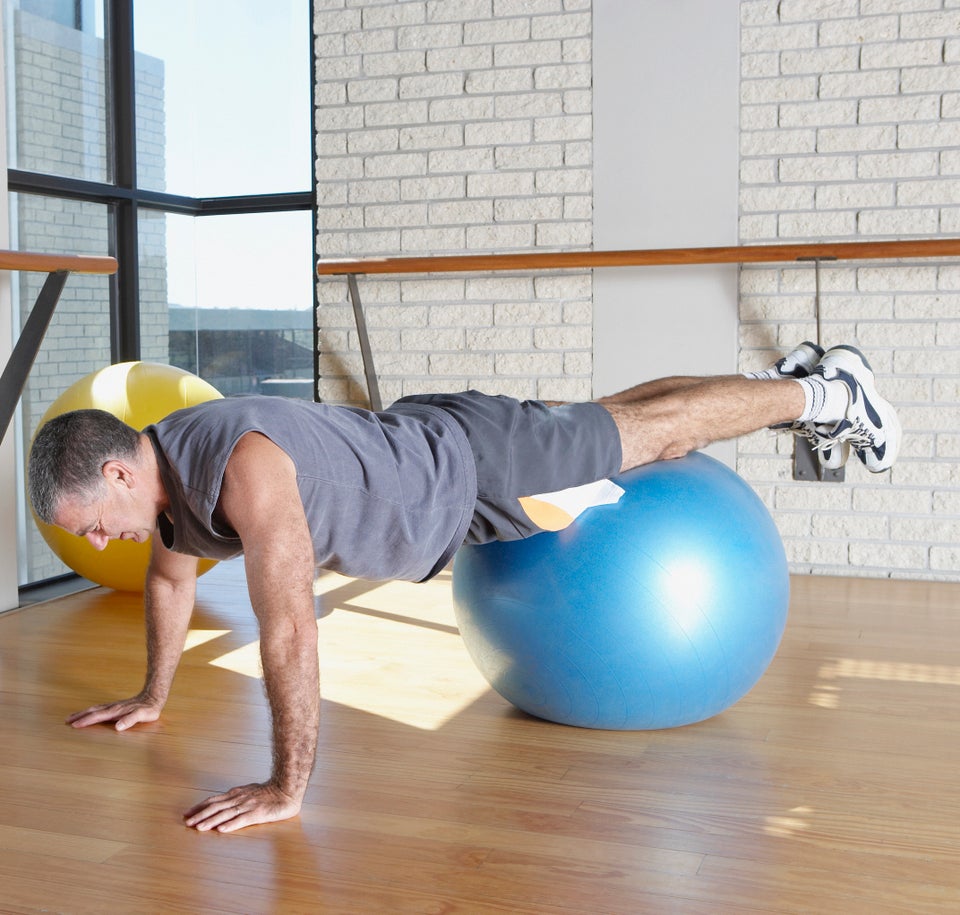Thinking of trying a new fitness class this year? The bright lights, crazy music, and enviably fit instructors can make stepping out of your sweaty comfort zone scarier than it should be. But it doesn't have to be this way, says celebrity trainer Astrid Swan, a fan-favorite Barry's Bootcamp instructor in Los Angeles. "Your attitude is everything."
And of course, you know that. But still, those negative, self-conscious thoughts we all have can make you less likely to give a new class a fair try, and they may even lead to a crap workout, complete with poor form or even injuries.
We tapped Swan and Amanda Freeman, founder of the Pilates-meets-cardio studio SLT, for a little advice on easing these common first-timer fears.
1. "I'll just hide here in the back of the room."
You may think going incognito in the corner is a genius way to calm your nerves. The reality is, you're doing yourself a disservice by distancing yourself from the instructor. Take a deep breath and position yourself right in the thick of it, suggests Freeman. Go for a spot closer to the center of the room where you have both a clear view of the instructor and the mirror to check your form.
Trying a new class with a friend? You may want to space yourselves out. "We make sure that newbies aren't right next to each other," Freeman adds. "It helps to have experienced folks on either side for when you are confused and need to look at someone to know what should be going on."
2. "Great, a super-toned clique congregating in the front."
It's true, lots of fitness fads attract a cult following of sorts. (SoulCycle, we're lookin' at you.) Don't let that discourage you from signing up or make you settle for the last row. It's helpful to remember that they, too, were once in your newbie shoes and wondering how one musters up the bravery to cozy up close to the mirrors.
Go ahead and chat up your neighbor, who may be a great additional resource, Swan recommends.
"In my experience, the cult followers will take you under their wing. They will tell you how crazy the trainer is but how awesome it is too," Swan says. "They'll take you in, show you where things are located, even cheer you on during the workout."
3. "I don't have the right gear. God, I must look like an idiot."
Although there are times when you need special gear, most classes and studios are up front about items you'll need to bring with you. Just do your homework ahead of time: Check the FAQ section of the website or find a review online that can give you an idea of whether, say, grippy-bottom socks or hand wraps are required. "If it's still not clear, call the studio and ask, or check out the studio's social media to see what the typical gear is," Freeman says. (Many classes allow first-timers to borrow supplies.)
Then, there's the special gear you don't need to dwell on. Case in point: (overpriced) studio merchandise that's not necessary for the actual class. Some may feel "cool" wearing it, but unless their promotional tanks and Spandex are made of some secret calorie-torching fabric we've never heard of, it's not worth sweating over--pun intended.
Wear what makes you feel strong and confident in a gym setting; psychologists believe this idea of dressing the part--dubbed "enclothed cognition"--may actually improve your workout performance.
4. "This instructor is terrifying."
Trainers often boast big muscles and a big attitude--but those are job requirements, not scare tactics. With a quick introduction, you'll realize they don't bite. Swan urges, "Don't be afraid to talk to us."
And building that rapport benefits your actual workout, explains Freeman. "Creating a relationship with the instructor will also make it more likely that they pay extra attention to you throughout class," says Freeman.
Top-notch instructors will usually ask if anyone is a first-timer and introduce him or herself first and inquire about whether you have any injuries or limitations, Swan adds. "We want to get to know you!"
5. "WTF is this machine?"
Equipment like rowing machines, Pilates reformers and boxing bags may feel foreign if it's your first time trying them out, but you don't let that keep you from class. The easy fix: Get there early and ask for a quick tutorial (if the staff doesn't beat you to it!). "I suggest arriving at class at least 10 to 15 minutes before it is scheduled to start," Freeman advises. Plus, you can often get a peek at the class right before yours for a little preview of what you're in for.
6. "Did that girl just grab 20-lb. weights?!"
Relax, you're not at the CrossFit Games. In other words, it's not a competition. Comparing your abilities to the gal beside you can also set you up for injury, Freeman cautions. "Never do anything you aren't comfortable with, and don't give into peer pressure. Everyone is different and everyone's bodies respond differently to different weight loads," she says. "Screw the 20-pounders and grab the 5-pounders if that's what you're feeling. Even I won't pick up a weight bigger than 8 pounds--ever!"
Instructors are also there to help you with your equipment needs. "We can usually gauge your level. Don't be ashamed either if you have to grab something lighter. Form is way more important," says Swan. "If you are not sure, you can grab two different set of weights, just be mindful of your space."
7. "I'm the only one sweating--and it's only the warm up. I hate this."
Don't let the first 10 to 15 minutes make you fear the rest of the session or feel out of shape. If you've never tried that type of workout, you're likely putting to work different muscles, and your body will need to adjust to the challenge.
Think about it, "Did you fall a few times as baby when you started to walk?" Swan asks. "I don't expect anyone to come into my class and not struggle a little. Some of my clients used to hate my class, but then they realized that I really do have your best interest in mind."
8. "I am so uncoordinated I should just leave this class."
Not trying to be harsh, but news flash: No one is looking at you. So just do your best! What matters is that you're moving, not that you're moving in perfect sync with your entire class.
9. "It's over, and I survived."
Whether you hated your sweat session or totally drank the Kool-Aid, you did it, so congrats! After class, says Swan, you should regroup with the instructor: "Talk to us again! The first class is overwhelming, and we understand that--we also want you to come back. We are here for you."
Keep in mind that there are some workouts you may not fall in love with right away or they take a few tries to get the hang of, explains Freeman. "That said, you will likely know the first time that it's something you could see yourself getting into. For those classes, give them a round two for sure."
If at any point you felt unsafe or just didn't like how the class made you feel, there's no shame in checking it off your list for good. "Move on and try something else," Freeman says. "There are lots of options out there."
Too much treadmill
Getty
If you have any joint pain (in the ankle, knee, or hip) or have had a joint replaced, walking or running on a treadmill can exacerbate pain, especially in your knees, says Thornton. "When you walk on the ground, you are moving over the area that you're walking on. When you walk on a treadmill, the ground is moving underneath you—it fires your [thigh] muscles more than with regular walking."And as for your exertion level, "walking a mile or two over 30 minutes is going to be as beneficial as running that two miles in a quarter of the time," he advises. "The difference is, one may get you injured, and one definitely won't." Score another for good old walking!
Using overly heavy weights
Getty
Gym culture can be a little intimidating, with those long racks of heavy weights and machines with an infinite variety of pulleys, bars, and benches. But one thing is for sure: You should never push yourself to exhaustion with heavy weights. "People from 45 to 80 can do resistance exercise, but it needs to be adjusted to what you can and can't do," says Thornton. In other words, trust your body's signals."You don't need to push yourself," he says. "If you're doing bench presses and on the last rep, you have to arch your back to lift the bar, you're lifting too much weight. If you can't do a workout without compensation, it's too much weight and may cause injury." Pain beyond a little muscle soreness means you should stop the exercise, Thornton cautions.
Ignoring your "balance muscles"
Getty
What are balance muscles? Really, your entire muscular system aids in keeping your body balanced, but the key muscle groups are your core (stomach and lower to middle back muscles) and the gluteal muscles that comprise your rear end. To get a physical understanding of where your core muscles are, activate them by holding in your stomach and bearing down as if you're going to do a crunch. And to activate your glute muscles, stand with your hands against a wall, shift your weight to one foot, and lift your raised leg straight out behind you."Train your body to get balance from your core rather than by compensating," says Thornton. "If you're falling, you might throw out a leg to stop yourself. But that's compensating. A strong core will take over and bring you back to center more efficiently." And strong glute muscles will help you maintain your side-to-side balance, he says.
Squatting with your weight forward
Getty
Squats are a super beneficial exercise, strengthening the muscles in the front and back of your thigh (quads and hamstrings) and rear end muscles (glutes). This bend and lift movement mimics what people do when picking up a bag off the floor or picking up a grandchild, says Jacque Ratliff, an exercise physiologist at the
American Council on Exercise. But commonly, people allow their knees to jut forward past their toes when squatting, she says."Always
make sure your hips are moving backward ," says Ratliff. "Think about sitting down and back in a chair. It takes stress off the knees, hips, ankles, and major joints. Plus, when your hips are moving backward, it allows you to use the bigger muscles (quads, hamstrings, glutes)."
Final tips: Keep your back straight to protect your lower back, and squatting with just your body weight is still considered strength training.
Having bad crunching habits
Getty
If you do crunches with your feet braced down by a heavy object or under someone's hands, you're strengthening your front stomach muscles to an extent, but you're mostly working your hip flexors (the muscles located on your upper thighs, just below the hipbone), says Thornton. When doing crunches, feet should be in the air (pictured), on the ground, or resting on a bench or couch, and you should lift your torso until your shoulder blades just leave the ground, he says. "A full range of motion is not necessary."Plus, when training your core muscles, crunches are only part of the equation. You'll have a stronger core and better balance if you do exercises that rotate your torso, thereby strengthening important muscles in the front and side of the stomach and all along your spine, says Ratliff.Exercise: Either seated on a bench (or armless chair) or standing with your feet shoulder-width apart, hold a ball or light weight in your hands and twist your torso all the way from one side to the other, moving your arms with it.
Assuming push-ups are too hard for you
Getty
No certified trainer would ever tell you that push-ups have to be done on the ground, with your body supported solely by your hands and toes. This powerhouse exercise (which works your chest, shoulders, arms, upper back, and core muscles) is just as effective—and much less intimidating—with your knees on the ground (pictured), or even done in a standing position against a wall, says Ratliff.Exercise: To do standing push-ups, stand facing a wall at arm's length with your feet hip-width apart and legs in a comfortable stance. Put your arms straight out to match the height of your shoulders and place your hands on the wall. Slowly bend your arms, keeping your back straight until your forehead touches the wall. Straighten your arms and repeat. To make this exercise more challenging, start the movement with your body further from the wall, says Ratliff. "You can also stagger your feet, on just ahead of the other, to make it easier."
Leaning to one side when stepping up
Getty
The No. 1 rule of proper step-up form: Make sure your body is centered. Leaning over to one side or relying heavily on a railing limits the efficacy of this movement, says Ratliff. This basic strength training exercise targets the leg and rear end muscles, and can improve balance and make everyday activities, like taking the stairs and using a step stool, easier. Final Tips: Feel free to adjust the level of your step-up to match your fitness level, says Ratliff. And if someone is spotting you, he or she should be positioned in front of you while lightly holding your hands, to keep your balance centered.
Rowing with hunched shoulders
Getty
The entire pulling motion achieved using a rowing machine helps strengthen the muscles in your legs and torso, as well as in your upper back, which unrounds the shoulders and improves posture, says Ratliff. But there can be an inclination to shrug your shoulders up towards your ears when doing this exercise, which makes it much less efficient. Proper form dictates that you lower your shoulders and then squeeze your shoulder blades back towards one another, keeping your back straight and leaning back slightly."You can also do this standing using a light resistance band attached to a door handle," says Ratliff. "If you have a partner, you can hold two ends of a towel and have the second person stand in front of you and hold the towel in the middle. Get the grandkids involved!"
Our 2024 Coverage Needs You
It's Another Trump-Biden Showdown — And We Need Your Help
The Future Of Democracy Is At Stake
Our 2024 Coverage Needs You
Your Loyalty Means The World To Us
As Americans head to the polls in 2024, the very future of our country is at stake. At HuffPost, we believe that a free press is critical to creating well-informed voters. That's why our journalism is free for everyone, even though other newsrooms retreat behind expensive paywalls.
Our journalists will continue to cover the twists and turns during this historic presidential election. With your help, we'll bring you hard-hitting investigations, well-researched analysis and timely takes you can't find elsewhere. Reporting in this current political climate is a responsibility we do not take lightly, and we thank you for your support.
Contribute as little as $2 to keep our news free for all.
Can't afford to donate? Support HuffPost by creating a free account and log in while you read.
The 2024 election is heating up, and women's rights, health care, voting rights, and the very future of democracy are all at stake. Donald Trump will face Joe Biden in the most consequential vote of our time. And HuffPost will be there, covering every twist and turn. America's future hangs in the balance. Would you consider contributing to support our journalism and keep it free for all during this critical season?
HuffPost believes news should be accessible to everyone, regardless of their ability to pay for it. We rely on readers like you to help fund our work. Any contribution you can make — even as little as $2 — goes directly toward supporting the impactful journalism that we will continue to produce this year. Thank you for being part of our story.
Can't afford to donate? Support HuffPost by creating a free account and log in while you read.
It's official: Donald Trump will face Joe Biden this fall in the presidential election. As we face the most consequential presidential election of our time, HuffPost is committed to bringing you up-to-date, accurate news about the 2024 race. While other outlets have retreated behind paywalls, you can trust our news will stay free.
But we can't do it without your help. Reader funding is one of the key ways we support our newsroom. Would you consider making a donation to help fund our news during this critical time? Your contributions are vital to supporting a free press.
Contribute as little as $2 to keep our journalism free and accessible to all.
Can't afford to donate? Support HuffPost by creating a free account and log in while you read.
As Americans head to the polls in 2024, the very future of our country is at stake. At HuffPost, we believe that a free press is critical to creating well-informed voters. That's why our journalism is free for everyone, even though other newsrooms retreat behind expensive paywalls.
Our journalists will continue to cover the twists and turns during this historic presidential election. With your help, we'll bring you hard-hitting investigations, well-researched analysis and timely takes you can't find elsewhere. Reporting in this current political climate is a responsibility we do not take lightly, and we thank you for your support.
Contribute as little as $2 to keep our news free for all.
Can't afford to donate? Support HuffPost by creating a free account and log in while you read.
Dear HuffPost Reader
Thank you for your past contribution to HuffPost. We are sincerely grateful for readers like you who help us ensure that we can keep our journalism free for everyone.
The stakes are high this year, and our 2024 coverage could use continued support. Would you consider becoming a regular HuffPost contributor?
Dear HuffPost Reader
Thank you for your past contribution to HuffPost. We are sincerely grateful for readers like you who help us ensure that we can keep our journalism free for everyone.
The stakes are high this year, and our 2024 coverage could use continued support. If circumstances have changed since you last contributed, we hope you'll consider contributing to HuffPost once more.
Already contributed? Log in to hide these messages.



